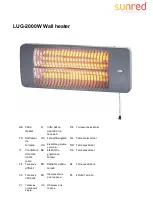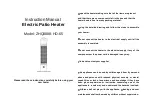
10
Installation Instructions and Owner’s Manual
Unvented Liquid Propane Fired Room Heater
OPERATING YOUR HEATER
FOR YOUR SAFETY READ BEFORE LIGHTING
WARNING:
If you do not follow these instructions
exactly, a fire or explosion may result causing property
damage, personal injury or loss of life.
A. This appliance has a pilot that must be lighted by hand.
When lighting the pilot, follow these instructions exactly.
B. BEFORE LIGHTING smell all around the appliance area
for gas. Be sure to smell next to the floor because some
gas is heavier than air and will settle on the floor.
WHAT TO DO IF YOU SMELL GAS
•
Shut off gas supply.
•
Do not try to light any appliance.
•
Do not touch any electrical switch; do not use any
phone in your building.
• Immediately call you gas supplier from a neighbor’s
phone. Follow the gas supplier’s instructions.
•
If you can not reach your gas supplier, call the fire
department.
C. Use only your hand to push in or turn the gas control knob.
Never use tools. If knob will not push in or turn by hand,
don’t try to repair it; call a qualified service technician or gas
supplier. Force or attempted repair may result in a fire or
explosion.
D. Do not use this appliance if any part has been
underwater. Immediately call a qualified service
technician to inspect the appliance and to replace any
part of the control system which has been under water.
LIGHTING INSTRUCTIONS
1.
STOP!
Read the all safety information included with and
on the side of heater.
2. Check that gas supply to heater is on.
3. Push in gas control knob and slightly turn clockwise
to
the OFF position (see figure 16).
Note:
Knob cannot be turned from PILOT to OFF unless
knob is pushed in slightly. Do not force.
4. Wait five (5) minutes to clear out any gas. Then smell
for gas, including near the floor. If you smell gas,
STOP!
Follow “B” in the safety information above. If you do not
smell gas, go to the next step.
5. Push in gas control know slightly and turn
counterclockwise
to PILOT/IGN and depress for five
(5) seconds.
Note:
The first time that the heater is operated after
connecting the gas supply, the control knob should be
depressed for about 30 seconds. This will allow air to bleed
from the gas system.
6. Push in control knob and rotate control knob back to
OFF position then rotate counterclockwise
to PILOT/
IGN position. This will light pilot. If needed gently keep
rotating control knob back and forth while depressed
until pilot lights.
7. Keep control knob depressed in for ten (10) seconds after
lighting pilot. If pilot goes out, repeat steps 4, 5, 6 and 7.
If pilot does not stay lit, refer to Troubleshooting, pages
12-13. Also, contact a qualified service person or gas
supplier for repairs.
If control knob does not pop up when released, contact a
qualified service person or gas supplier for repairs.
8. FOR MHVFRD10LP:
• Turn control knob to “HI” to light heater. Leave on “HI”
position until the tiles have turned bright orange.
•
After the burner tiles have turned bright orange, adjust
heat output by turning Control Knob to desired position
(“LO” or “HI”).
FOR MHVFBF10LP:
• When the pilot is lit, turn the control knob to “HI”
position to light.
• After flame is established on “HI”, adjust heat output by
turning control knob to desired position (“LO” or “HI”).
Do not operate heater between locked positions.
Control Knob
Figure 15
CAUTION:
Do not try to adjust heating level by using
equipment shutoff valve.
WARNING:
When running heater, set control knob at
“LO” or “HI” locked positions. Poor combustion and
higher levels of carbon monoxide may result if heater is
operated with control knob positioned between locked
positions.
IMPORTANT:
Release downward pressure while turning
control knob. Control knob must be locked at the desired
position.
TO TURN OFF GAS TO APPLIANCE
SHUTTING OFF HEATER:
1. Turn off equipment shutoff valve.
2. Turn control knob clockwise
to the OFF
position.
SHUTTING OFF BURNER ONLY (PILOT STAYS LIT)
1. Turn control knob clockwise
to the PILOT/IGN
position.
INSPECTING BURNER
Check pilot flame pattern and burner flame pattern often.


































